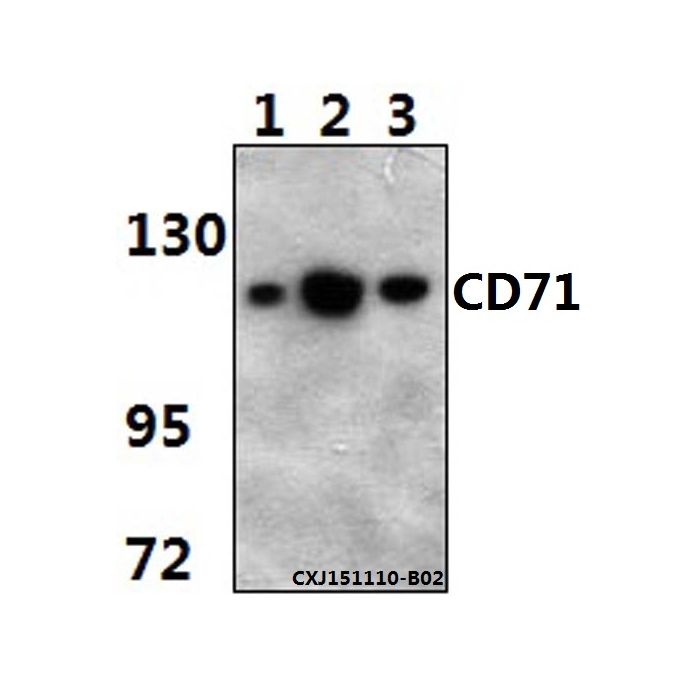CD71 (TfR1) (clone 5C9) , anti-human, mouse, rat
€328.00
In stock
SKU
MB8615
Background:
Cellular uptake of iron occurs via receptor mediated endocytosis of ligand occupied transferrin receptor into specialized endosomes. Endosomal acidification leads to iron release. The apotransferrin receptor complex is then recycled to the cell surface with a return to neutral pH and the concomitant loss of affinity of apotransferrin for its receptor. Transferrin receptor is necessary for development of erythrocytes and the nervous system (By similarity). Useful in studies of dividing haematopoietic and tumour cell populations, and metabolic activity. A second ligand, the heditary hemochromatosis protein HFE, competes for binding with transferrin for an overlapping C terminal binding site. The antigen is present on most dividing cells, including normally cycling in vivo hematopoietic progenitor cells, mitogenically stimulated cells in vitro, some primary tumor cells and most proliferating cells in vitro.The transferrin receptor has been structurally characterized as a sulfide bound dimer of identical glycoprotein subunits of 95 kDa.
Alternative Name:
Transferrin receptor protein 1, TR, TfR, TfR1, Trfr, p90, CD71, Transferrin receptor protein 1, serum form, sTfR, TFRC
Application Dilution: WB: 1:500~1:1000
Specificity: CD71 monoclonal antibody detects endogenous levels of CD71 protein.
Immunogen:
A synthetic peptide corresponding to residues in Human CD71.
MW: ~ 120 kDa
Swis Prot.: P02786
Purification & Purity:
The antibody was affinity-purified from mouse antiserum by affinity-chromatography using epitope-specific immunogen and the purity is > 95% (by SDS-PAGE).
Format:
1 mg/ml in Phosphate buffered saline (PBS) with 0.05% sodium azide, approx. pH 7.3.
Storage:
Store at 4°C short term. Aliquot and store at -20°C long term. Avoid freeze-thaw cycles.
For research use only, not for use in diagnostic procedure.
Cellular uptake of iron occurs via receptor mediated endocytosis of ligand occupied transferrin receptor into specialized endosomes. Endosomal acidification leads to iron release. The apotransferrin receptor complex is then recycled to the cell surface with a return to neutral pH and the concomitant loss of affinity of apotransferrin for its receptor. Transferrin receptor is necessary for development of erythrocytes and the nervous system (By similarity). Useful in studies of dividing haematopoietic and tumour cell populations, and metabolic activity. A second ligand, the heditary hemochromatosis protein HFE, competes for binding with transferrin for an overlapping C terminal binding site. The antigen is present on most dividing cells, including normally cycling in vivo hematopoietic progenitor cells, mitogenically stimulated cells in vitro, some primary tumor cells and most proliferating cells in vitro.The transferrin receptor has been structurally characterized as a sulfide bound dimer of identical glycoprotein subunits of 95 kDa.
Alternative Name:
Transferrin receptor protein 1, TR, TfR, TfR1, Trfr, p90, CD71, Transferrin receptor protein 1, serum form, sTfR, TFRC
Application Dilution: WB: 1:500~1:1000
Specificity: CD71 monoclonal antibody detects endogenous levels of CD71 protein.
Immunogen:
A synthetic peptide corresponding to residues in Human CD71.
MW: ~ 120 kDa
Swis Prot.: P02786
Purification & Purity:
The antibody was affinity-purified from mouse antiserum by affinity-chromatography using epitope-specific immunogen and the purity is > 95% (by SDS-PAGE).
Format:
1 mg/ml in Phosphate buffered saline (PBS) with 0.05% sodium azide, approx. pH 7.3.
Storage:
Store at 4°C short term. Aliquot and store at -20°C long term. Avoid freeze-thaw cycles.
For research use only, not for use in diagnostic procedure.
| Is Featured? | No |
|---|
Write Your Own Review

